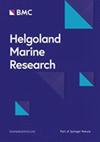Non-indigenous species (NIS) of polychaetes (Annelida: Polychaeta) from the Atlantic and Mediterranean coasts of the Iberian Peninsula: an annotated checklist
4区 地球科学
Q2 Agricultural and Biological Sciences
引用次数: 22
Abstract
This study provides an updated catalogue of non-indigenous species (NIS) of polychaetes reported from the continental coasts of the Iberian Peninsula based on the available literature. A list of 23 introduced species were regarded as established and other 11 were reported as casual, with 11 established and nine casual NIS in the Atlantic coast of the studied area and 14 established species and seven casual ones in the Mediterranean side. The most frequent way of transport was shipping (ballast water or hull fouling), which according to literature likely accounted for the introductions of 14 established species and for the presence of another casual one. To a much lesser extent aquaculture (three established and two casual species) and bait importation (one established species) were also recorded, but for a large number of species the translocation pathway was unknown. About 25% of the reported NIS originated in the Warm Western Atlantic region, followed by the Tropical Indo West-Pacific region (18%) and the Warm Eastern Atlantic (12%). In the Mediterranean coast of the Iberian Peninsula, nearly all the reported NIS originated from warm or tropical regions, but less than half of the species recorded from the Atlantic side were native of these areas. The effects of these introductions in native marine fauna are largely unknown, except for one species (Ficopomatus enigmaticus) which was reported to cause serious environmental impacts. In other cases, the displacement of native species or economic damages are suspected.来自伊比利亚半岛大西洋和地中海沿岸的多毛纲(环节动物:多毛纲)的非本地种(NIS):一份注释清单
本研究在现有文献的基础上,对伊比利亚半岛大陆海岸报道的多毛类非本地物种(NIS)进行了更新目录。研究区大西洋沿岸有11个已建立的外来物种,9个为非正式的外来物种;地中海沿岸有14个已建立的物种,7个为非正式的外来物种。最常见的运输方式是航运(压舱水或船体污垢),根据文献,这可能是14种已知物种的引入和另一种偶然物种的存在。在较小程度上,也记录了水产养殖(3个已建立物种和2个临时物种)和饵料进口(1个已建立物种),但对于大量物种的易位途径是未知的。报告的NIS中约有25%来自温暖的西大西洋地区,其次是热带印度-西太平洋地区(18%)和温暖的东大西洋地区(12%)。在伊比利亚半岛的地中海沿岸,几乎所有报告的新物种都起源于温暖或热带地区,但在大西洋一侧记录的物种中,只有不到一半是这些地区的原生物种。这些引进对本地海洋动物的影响在很大程度上是未知的,除了一种物种(Ficopomatus enigmaticus)据报道会造成严重的环境影响。在其他情况下,可能会造成本地物种的迁移或经济损失。
本文章由计算机程序翻译,如有差异,请以英文原文为准。
求助全文
约1分钟内获得全文
求助全文
来源期刊

Helgoland Marine Research
地学-海洋学
自引率
0.00%
发文量
0
审稿时长
6-12 weeks
期刊介绍:
Helgoland Marine Research is an open access, peer reviewed journal, publishing original research as well as reviews on all aspects of marine and brackish water ecosystems, with a focus on how organisms survive in, and interact with, their environment.
The aim of Helgoland Marine Research is to publish work with a regional focus, but with clear global implications, or vice versa; research with global emphasis and regional ramifications. We are particularly interested in contributions that further our general understanding of how marine ecosystems work, and that concentrate on species’ interactions.
 求助内容:
求助内容: 应助结果提醒方式:
应助结果提醒方式:


